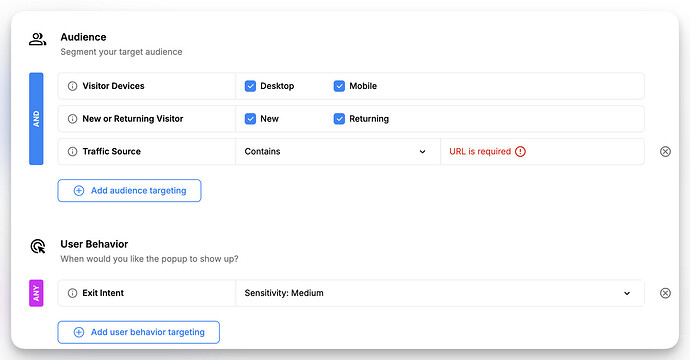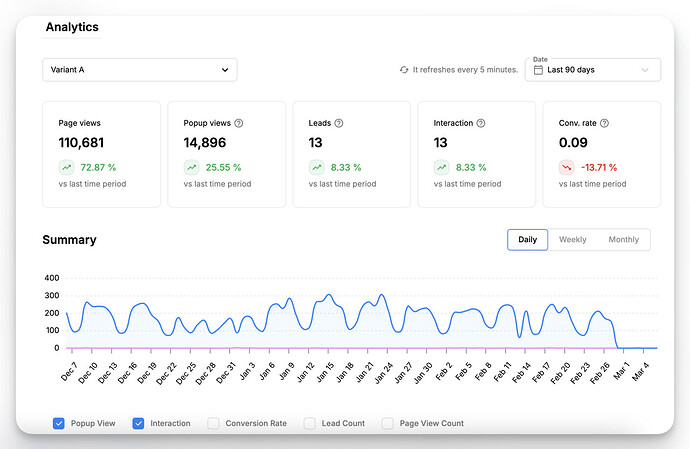I’m glad the examples were helpful ![]() Since you’re offering experiences (like cooking and art workshops) instead of products, you’re right!
Since you’re offering experiences (like cooking and art workshops) instead of products, you’re right!
Here are a few suggestions that might suit a service-based business model more effectively:
1. Tailor the Offer to Experiences
- Exclusive Sneak Peek: Offer a short free preview or mini-lesson from one of your most popular classes. For instance, if you host cooking workshops, provide a mini recipe PDF or a short cooking technique video.
- Early Bird Access: If you have new workshops coming up, consider giving exit-intent visitors first dibs on enrollment before the general public.
- Bonus Materials: Provide a free workbook, “Top 5 Tips for Perfect Homemade Pasta,” or an art course “Beginner’s Guide to Watercolors” PDF. These can feel just as valuable as a monetary discount, and are perfectly aligned with your brand.
Such offers turn a casual browser into a lead because they get a taste of what you provide, and it sets your business apart from a run-of-the-mill “10% off” approach.
2. Make It Easy to Opt Out
Encouraging an “opt-out” can actually boost conversions. Why? Because it makes users feel like they have a real choice. For example:
- Primary CTA: “Get a Free Mini Recipe Book!”
- Opt-Out Text: “No thanks, I’m not interested in new recipes.”
It sounds so counterintuitive that people often think twice before opting out. You’re subtly reinforcing your offer’s value and giving them a light nudge toward a “Yes.”
3. Segment Different Audiences
- New vs. Returning Visitors: Show first-timers an enticing free mini ebook or “Free 15-Minute Taster Workshop.” Meanwhile, returning visitors might see an exit-intent offer for a future or advanced class.
- Email Subscribers vs. Non-Subscribers: Current subscribers don’t need the same popup to sign up for your newsletter again. Instead, you could show them a specialized upgrade (e.g., a loyalty perk or advanced workshop discount).
- Frequent Browsers vs. Cart Abandoners: If someone consistently visits your workshop pages, greet them with a special “Inner Circle” invite or advanced sign-up for an upcoming workshop.
The more you tailor your exit popups to specific segments, the more relevant they will be. Below you can see how to group your visitors by traffic source and exit intent targeting with Popupsmart:
4. Go Mobile-Friendly
We tend to think of exit-intent triggers as mouse movement, but on mobile, it’s often about scroll direction or browser back taps.
Luckily, Popupsmart can detect that behavior on mobile and display your popup accordingly. Just ensure your design is responsive so the content is just as crisp on a phone as on a desktop.
5. Consider Adding a Sense of Urgency or Scarcity
Even if you’re selling experiences, scarcity still works wonders. You might say something like:
- “Only 3 seats left for next week’s Pasta Making Workshop!”
- “We only run this Art 101 class twice a year, don’t miss your chance!”
I mentioned in a previous Community content that the percentage of people make purchases due to FOMO is 60. You can also jump into this conversation for more statistical proof. When visitors realize opportunities are limited, they’re more likely to reconsider leaving without signing up.
6. Use Attention-Grabbing Words
Persuasive words like “Wait!” or “Before you go…” can disrupt the user’s exit and spark curiosity. An inviting headline, followed by the benefit of your offer, can convince them to stick around a bit longer. For example:
- Headline: “Wait! Want to Learn Homemade Sushi in 10 Minutes?”
- CTA: “Yes, Send Me the Free Sushi Cheat Sheet!”
This short moment can open the door to a sign-up or booking.
9. Test Everything (A/B Testing)
The best way to discover which words, images and offers connect the most with your audience is to test your popups.
- Test Headlines: Compare “Free Cooking Tips” vs. “Exclusive Recipe eBook.”
- Test Timing: Does the popup convert better if triggered after 10 seconds on the site vs. on exit-intent only?
- Test Visuals: A bright, bold photo of a mouthwatering dish vs. a simple, minimal design.
Regularly review your popup stats in Popupsmart to see which version resonates best.
Tools like Google Analytics and your email marketing platform can help you connect these dots. Popupsmart has built-in analytics as well, making it simpler to monitor performance, see which version of your popup is working best, and continue to optimize over time.


